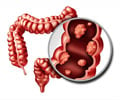Researchers have developed a two-pronged molecular weapon that kills cancer cells in lab tests.
By joining a sugar to a short-chain fatty acid compound, Johns Hopkins researchers have developed a two-pronged molecular weapon that kills cancer cells in lab tests. The researchers cautioned that their double-punch molecule has not yet been tested on animals or humans. Nevertheless, they believe it represents a promising new strategy for fighting the deadly disease.
“For a long time, cancer researchers did not pay much attention to the use of sugars in fighting cancer,” said Gopalan Sampathkumar, a postdoctoral fellow in the university's Department of Biomedical Engineering and lead author of the journal article. “But we found that when the right sugar is matched with the right chemical partner, it can deliver a powerful double-whammy against cancer cells.”Sampathkumar and his colleagues built upon 20-year-old findings that a short-chain fatty acid called butyrate can slow the spread of cancer cells. In the 1980s, researchers discovered that butyrate, which is formed naturally at high levels in the digestive system by symbiotic bacteria that feed on fiber, can restore healthy cell functioning.
Efforts to use butyrate as a general drug for tumors elsewhere in the body, however, have been hindered by the high doses of the compound needed to effectively eradicate cancer. To get around this problem, scientists have tried to make butyrate more potent by modifying it or joining it to other compounds. Usually, the results have been disappointing because the molecular partner added to butyrate to improve delivery to the cancer cells often produced unsafe side effects.
In some of the less successful experiments, designed to avoid toxic side effects, researchers used innocuous sugar molecules such as glucose to carry butyrate into the cells. The Johns Hopkins team tried a different tack. “We didn’t think they chose the right partner molecule,” said Kevin J. Yarema, an assistant professor of biomedical engineering who supervised the project. “Our insight was to select the sugar partner to serve not just as a passive carrier but as additional ammunition in the fight against cancer.”
The researchers focused on a sugar called N-acetyl-D-mannosamine, or ManNAc, for short. The team created a hybrid molecule by linking ManNAc with butyrate. The hybrid easily penetrates a cell’s surface, then is split apart by enzymes inside the cell. Once inside the cell, ManNAc is processed into another sugar known as sialic acid that plays key roles in cancer biology, while butyrate orchestrates the expression of genes responsible for halting the uncontrolled growth of cancer cells.
Although the study of the exact molecular mechanism is in its early stages, the researchers believe the separate chemical components work together to bolster the cancer-fighting power of butyrate. The double attack triggers cellular suicide, also called apoptosis, in the cancer cells.
Advertisement
The researchers also wanted to find out whether administering the two parts of the hybrid independently would achieve the same result. But in these experiments, the cancer cells did not self-destruct. The researchers suspect this is because the hybrid molecules more easily penetrate the surface of the cell than the individual chemicals. Once the components are inside, the researchers believe the partners help enzymes to resume the normal assembly of sugar molecules and correct aberrant gene expression patterns, two processes that go awry when cancer occurs.
Advertisement
Source-Newswise
SRM










